[English] 日本語
 Yorodumi
Yorodumi- PDB-2k42: Solution Structure of the GTPase Binding Domain of WASP in Comple... -
+ Open data
Open data
- Basic information
Basic information
| Entry | Database: PDB / ID: 2k42 | ||||||
|---|---|---|---|---|---|---|---|
| Title | Solution Structure of the GTPase Binding Domain of WASP in Complex with EspFU, an EHEC Effector | ||||||
 Components Components |
| ||||||
 Keywords Keywords |  SIGNALING PROTEIN / SIGNALING PROTEIN /  WASP / EspFU / GBD / autoinhibition / WASP / EspFU / GBD / autoinhibition /  Cytoplasm / Cytoplasm /  Cytoskeleton / Disease mutation / Cytoskeleton / Disease mutation /  Phosphoprotein Phosphoprotein | ||||||
| Function / homology |  Function and homology information Function and homology informationregulation of T cell antigen processing and presentation / regulation of actin polymerization or depolymerization /  Cdc42 protein signal transduction / GTPase regulator activity / actin filament-based movement / negative regulation of cell motility / vesicle membrane / actin polymerization or depolymerization / Cdc42 protein signal transduction / GTPase regulator activity / actin filament-based movement / negative regulation of cell motility / vesicle membrane / actin polymerization or depolymerization /  regulation of stress fiber assembly / regulation of stress fiber assembly /  regulation of lamellipodium assembly ...regulation of T cell antigen processing and presentation / regulation of actin polymerization or depolymerization / regulation of lamellipodium assembly ...regulation of T cell antigen processing and presentation / regulation of actin polymerization or depolymerization /  Cdc42 protein signal transduction / GTPase regulator activity / actin filament-based movement / negative regulation of cell motility / vesicle membrane / actin polymerization or depolymerization / Cdc42 protein signal transduction / GTPase regulator activity / actin filament-based movement / negative regulation of cell motility / vesicle membrane / actin polymerization or depolymerization /  regulation of stress fiber assembly / regulation of stress fiber assembly /  regulation of lamellipodium assembly / negative regulation of stress fiber assembly / endosomal transport / positive regulation of double-strand break repair via homologous recombination / RHOJ GTPase cycle / regulation of lamellipodium assembly / negative regulation of stress fiber assembly / endosomal transport / positive regulation of double-strand break repair via homologous recombination / RHOJ GTPase cycle /  phospholipase binding / CDC42 GTPase cycle / Generation of second messenger molecules / RHO GTPases Activate WASPs and WAVEs / epidermis development / phagocytic vesicle / RAC1 GTPase cycle / actin filament polymerization / phospholipase binding / CDC42 GTPase cycle / Generation of second messenger molecules / RHO GTPases Activate WASPs and WAVEs / epidermis development / phagocytic vesicle / RAC1 GTPase cycle / actin filament polymerization /  T cell activation / T cell activation /  actin filament / FCGR3A-mediated phagocytosis / defense response / Regulation of actin dynamics for phagocytic cup formation / actin filament / FCGR3A-mediated phagocytosis / defense response / Regulation of actin dynamics for phagocytic cup formation /  small GTPase binding / small GTPase binding /  SH3 domain binding / cellular response to type II interferon / cell-cell junction / SH3 domain binding / cellular response to type II interferon / cell-cell junction /  blood coagulation / blood coagulation /  actin cytoskeleton / site of double-strand break / actin cytoskeleton / site of double-strand break /  actin binding / protein-containing complex assembly / host cell cytoplasm / actin binding / protein-containing complex assembly / host cell cytoplasm /  immune response / immune response /  protein kinase binding / positive regulation of transcription by RNA polymerase II / extracellular exosome / extracellular region / identical protein binding / protein kinase binding / positive regulation of transcription by RNA polymerase II / extracellular exosome / extracellular region / identical protein binding /  nucleus / nucleus /  plasma membrane / plasma membrane /  cytosol cytosolSimilarity search - Function | ||||||
| Biological species |   Homo sapiens (human) Homo sapiens (human)  Escherichia coli O157:H7 (bacteria) Escherichia coli O157:H7 (bacteria) | ||||||
| Method |  SOLUTION NMR / SOLUTION NMR /  simulated annealing simulated annealing | ||||||
 Authors Authors | Cheng, H.-C. / Skehan, B.M. / Campellone, K.G. / Leong, J.M. / Rosen, M.K. | ||||||
 Citation Citation |  Journal: Nature / Year: 2008 Journal: Nature / Year: 2008Title: Structural mechanism of WASP activation by the enterohaemorrhagic E. coli effector EspF(U). Authors: Cheng, H.C. / Skehan, B.M. / Campellone, K.G. / Leong, J.M. / Rosen, M.K. | ||||||
| History |
|
- Structure visualization
Structure visualization
| Structure viewer | Molecule:  Molmil Molmil Jmol/JSmol Jmol/JSmol |
|---|
- Downloads & links
Downloads & links
- Download
Download
| PDBx/mmCIF format |  2k42.cif.gz 2k42.cif.gz | 644.3 KB | Display |  PDBx/mmCIF format PDBx/mmCIF format |
|---|---|---|---|---|
| PDB format |  pdb2k42.ent.gz pdb2k42.ent.gz | 561.2 KB | Display |  PDB format PDB format |
| PDBx/mmJSON format |  2k42.json.gz 2k42.json.gz | Tree view |  PDBx/mmJSON format PDBx/mmJSON format | |
| Others |  Other downloads Other downloads |
-Validation report
| Arichive directory |  https://data.pdbj.org/pub/pdb/validation_reports/k4/2k42 https://data.pdbj.org/pub/pdb/validation_reports/k4/2k42 ftp://data.pdbj.org/pub/pdb/validation_reports/k4/2k42 ftp://data.pdbj.org/pub/pdb/validation_reports/k4/2k42 | HTTPS FTP |
|---|
-Related structure data
| Similar structure data |
|---|
- Links
Links
- Assembly
Assembly
| Deposited unit | 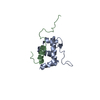
| |||||||||
|---|---|---|---|---|---|---|---|---|---|---|
| 1 |
| |||||||||
| NMR ensembles |
|
- Components
Components
| #1: Protein | Mass: 8128.908 Da / Num. of mol.: 1 / Fragment: CRIB domain, UNP residues 242-310 Source method: isolated from a genetically manipulated source Source: (gene. exp.)   Homo sapiens (human) / Gene: WAS, IMD2 / Production host: Homo sapiens (human) / Gene: WAS, IMD2 / Production host:   Escherichia coli (E. coli) / Strain (production host): BL21 (DE3) / References: UniProt: P42768 Escherichia coli (E. coli) / Strain (production host): BL21 (DE3) / References: UniProt: P42768 |
|---|---|
| #2: Protein/peptide | Mass: 4070.681 Da / Num. of mol.: 1 / Fragment: UNP residues 268-300 Source method: isolated from a genetically manipulated source Source: (gene. exp.)   Escherichia coli O157:H7 (bacteria) / Gene: tccP, ECs2715 / Production host: Escherichia coli O157:H7 (bacteria) / Gene: tccP, ECs2715 / Production host:   Escherichia coli (E. coli) / Strain (production host): BL21 (DE3) / References: UniProt: Q8X2D5, UniProt: P0DJ89*PLUS Escherichia coli (E. coli) / Strain (production host): BL21 (DE3) / References: UniProt: Q8X2D5, UniProt: P0DJ89*PLUS |
-Experimental details
-Experiment
| Experiment | Method:  SOLUTION NMR SOLUTION NMR | ||||||||||||||||||||||||||||||||
|---|---|---|---|---|---|---|---|---|---|---|---|---|---|---|---|---|---|---|---|---|---|---|---|---|---|---|---|---|---|---|---|---|---|
| NMR experiment |
|
- Sample preparation
Sample preparation
| Details |
| ||||||||||||
|---|---|---|---|---|---|---|---|---|---|---|---|---|---|
| Sample |
| ||||||||||||
| Sample conditions | pH: 6.8 / Pressure: ambient / Temperature: 298.15 K |
-NMR measurement
| NMR spectrometer |
|
|---|
- Processing
Processing
| NMR software |
| ||||||||||||||||||||||||
|---|---|---|---|---|---|---|---|---|---|---|---|---|---|---|---|---|---|---|---|---|---|---|---|---|---|
| Refinement | Method:  simulated annealing / Software ordinal: 1 simulated annealing / Software ordinal: 1 | ||||||||||||||||||||||||
| NMR representative | Selection criteria: lowest energy | ||||||||||||||||||||||||
| NMR ensemble | Conformer selection criteria: structures with the least restraint violations Conformers calculated total number: 50 / Conformers submitted total number: 20 |
 Movie
Movie Controller
Controller




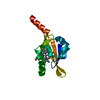
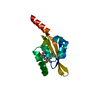



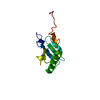
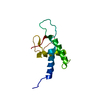

 PDBj
PDBj









